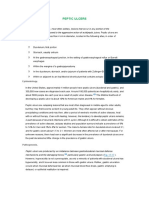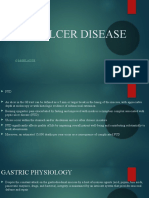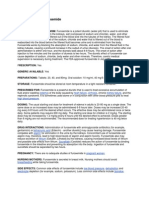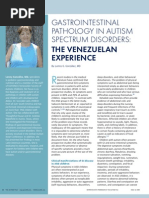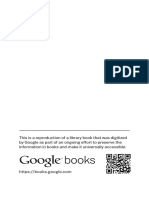0 ratings0% found this document useful (0 votes)
29 viewsBackground: View Media Gallery
Background: View Media Gallery
Uploaded by
Jayesh MahajanAtrophic gastritis is characterized by chronic inflammation and loss of gastric glands, replaced by intestinal-type epithelium or fibrous tissue. The two main causes are H. pylori infection and autoimmune gastritis. H. pylori infection typically causes multifocal atrophic gastritis affecting the antrum and corpus, while autoimmune gastritis is restricted to the corpus and fundus and may cause pernicious anemia. Both can lead to intestinal metaplasia and increased cancer risk over time as glands are destroyed.
Copyright:
© All Rights Reserved
Available Formats
Download as DOCX, PDF, TXT or read online from Scribd
Background: View Media Gallery
Background: View Media Gallery
Uploaded by
Jayesh Mahajan0 ratings0% found this document useful (0 votes)
29 views5 pagesAtrophic gastritis is characterized by chronic inflammation and loss of gastric glands, replaced by intestinal-type epithelium or fibrous tissue. The two main causes are H. pylori infection and autoimmune gastritis. H. pylori infection typically causes multifocal atrophic gastritis affecting the antrum and corpus, while autoimmune gastritis is restricted to the corpus and fundus and may cause pernicious anemia. Both can lead to intestinal metaplasia and increased cancer risk over time as glands are destroyed.
Original Description:
stomach
Original Title
gastritis
Copyright
© © All Rights Reserved
Available Formats
DOCX, PDF, TXT or read online from Scribd
Share this document
Did you find this document useful?
Is this content inappropriate?
Atrophic gastritis is characterized by chronic inflammation and loss of gastric glands, replaced by intestinal-type epithelium or fibrous tissue. The two main causes are H. pylori infection and autoimmune gastritis. H. pylori infection typically causes multifocal atrophic gastritis affecting the antrum and corpus, while autoimmune gastritis is restricted to the corpus and fundus and may cause pernicious anemia. Both can lead to intestinal metaplasia and increased cancer risk over time as glands are destroyed.
Copyright:
© All Rights Reserved
Available Formats
Download as DOCX, PDF, TXT or read online from Scribd
Download as docx, pdf, or txt
0 ratings0% found this document useful (0 votes)
29 views5 pagesBackground: View Media Gallery
Background: View Media Gallery
Uploaded by
Jayesh MahajanAtrophic gastritis is characterized by chronic inflammation and loss of gastric glands, replaced by intestinal-type epithelium or fibrous tissue. The two main causes are H. pylori infection and autoimmune gastritis. H. pylori infection typically causes multifocal atrophic gastritis affecting the antrum and corpus, while autoimmune gastritis is restricted to the corpus and fundus and may cause pernicious anemia. Both can lead to intestinal metaplasia and increased cancer risk over time as glands are destroyed.
Copyright:
© All Rights Reserved
Available Formats
Download as DOCX, PDF, TXT or read online from Scribd
Download as docx, pdf, or txt
You are on page 1of 5
Background
Atrophic gastritis is a histopathologic entity characterized by chronic
inflammation of the gastric mucosa with loss of the gastric glandular cells and
replacement by intestinal-type epithelium, pyloric-type glands, and fibrous
tissue. [1] Atrophy of the gastric mucosa is the endpoint of chronic processes,
such as chronic gastritis associated with Helicobacter pylori infection, other
unidentified environmental factors, and autoimmunity directed against gastric
glandular cells. [1] See the images below.
Atrophic gastritis. Helicobacter pylori–
associated chronic active gastritis (Genta stain, 20x). Multiple organisms
(brown) are observed adhering to gastric surface epithelial cells. A
mononuclear lymphoplasmacytic and polymorphonuclear cell infiltrate is
observed in the mucosa.
View Media Gallery
Atrophic gastritis. Intestinal
metaplasia of the gastric mucosa (Genta stain, 20x). Intestinal-type epithelium
with numerous goblet cells (stained blue with the Alcian blue stain) replace the
gastric mucosa and represent gastric atrophy. Mild chronic inflammation is
observed in the lamina propria. This pattern of atrophy is observed both in
Helicobacter pylori–associated atrophic gastritis and autoimmune gastritis.
View Media Gallery
The 2 main causes of atrophic gastritis result in distinct topographic types of
gastritis, which can be distinguished histologically. H pylori–associated
atrophic gastritis is usually a multifocal process that involves both the antrum
and the oxyntic mucosa of the gastric corpus and fundus, whereas
autoimmune gastritis essentially is restricted to the gastric corpus and fundus.
Individuals with autoimmune gastritis [2] may develop pernicious anemia
because of extensive loss of parietal cell mass and anti-intrinsic factor
antibodies.
H pylori–associated atrophic gastritis is frequently asymptomatic, but
individuals with this disease are at increased risk of developing gastric
carcinoma, which may decrease following H pylori eradication. [3] Patients with
chronic atrophic gastritis develop low gastric acid output and
hypergastrinemia, which may lead to enterochromaffin-like (ECL) cell
hyperplasia and carcinoid tumors. [4]
For patient education resources, see the Digestive Disorders Center, as well
as Gastritis.
The infection is usually acquired during childhood and progresses over the lifespan of
the individual if left untreated. The host response to the presence of H pylori is
composed of a T-lymphocytic and B-lymphocytic response, followed by infiltration of the
lamina propria and gastric epithelium by polymorphonuclear leukocytes (PMNs) that
eventually phagocytize the bacteria.
Significant damage associated with the release of bacterial and inflammatory toxic
products is inflicted on the gastric epithelial cells, resulting in increasing cell loss or
gastric atrophy over time. Weck published a study supporting their hypothesis that the
association between H pylori and chronic atrophic gastritis was greatly underestimated
due to the clearance of the infection in advanced stages of the disease. [5] These results
suggest that the association is much stronger than estimated by most epidemiologic
studies to date. Another study also reported that mannan-binding lectin allele (MBL2
codon 54 B) is associated with a higher risk of developing more severe gastric mucosal
atrophy in H pylori–infected Japanese patients. [6]
During the process of gastric mucosal atrophy, some glandular units develop an
intestinal-type epithelium, and intestinal metaplasia eventually occurs in multiple foci
throughout the gastric mucosa when atrophic gastritis is fully established. Other glands
are simply replaced by fibrous tissue, resulting in an expanded lamina propria. [7] Loss of
gastric glands in the corpus, or corpus atrophy, reduces parietal cell numbers, which
results in significant functional changes with decreased levels of acid secretion and
increased gastric pH. [8] Hypochloridia or achloridia raises serum gastrin levels, thereby
increasing the risk for the development of neuroendocrine tumors. [8] Studies have also
reported that moderate alcohol consumption may be associated with atrophic gastritis
by facilitating H pylori clearance. [9]
H pylori–associated chronic gastritis progresses with 2 main topographic patterns that
have different clinicopathologic consequences.
The first is antral predominant gastritis. Inflammation that is mostly limited to the antrum
characterizes antral predominant gastritis. Individuals with peptic ulcers usually develop
this pattern of gastritis, and it is the most frequently observed pattern in Western
countries.
The second is multifocal atrophic gastritis. Involvement of the corpus, fundus, and
gastric antrum with progressive development of gastric atrophy (ie, loss of gastric
glands) and partial replacement of gastric glands by intestinal-type epithelium (intestinal
metaplasia) characterize multifocal atrophic gastritis. Individuals who develop gastric
carcinoma and gastric ulcers usually have this pattern of gastritis. This pattern is
observed more often in developing countries and in Asia.
Autoimmune atrophic gastritis
The development of chronic atrophic gastritis limited to corpus-fundus mucosa and
marked diffuse atrophy of parietal and chief cells characterize autoimmune atrophic
gastritis, as shown in the following two images.
Patterns of atrophic gastritis
associated with chronic Helicobacter pylori infection and autoimmune gastritis.
View Media Gallery
Atrophic gastritis. Intestinal
metaplasia of the gastric mucosa (Genta stain, 20x). Intestinal-type epithelium
with numerous goblet cells (stained blue with the Alcian blue stain) replace the
gastric mucosa and represent gastric atrophy. Mild chronic inflammation is
observed in the lamina propria. This pattern of atrophy is observed both in
Helicobacter pylori–associated atrophic gastritis and autoimmune gastritis.
View Media Gallery
Autoimmune gastritis is associated with serum antiparietal and anti-intrinsic factor
antibodies that cause intrinsic factor (IF) deficiency, which, in turn, causes decreased
availability of cobalamin (vitamin B-12) and, eventually, pernicious anemia in some
patients.
Palladino reported that methylenetetrahydrofolate reductase (MTHFR) polymorphisms
may be associated with B12 deficiency and autoimmune atrophic
gastritis. [10] Autoantibodies are directed against at least 3 antigens, including IF,
cytoplasmic (microsomal-canalicular), and plasma membrane antigens. Two types of IF
antibodies are detected (types I and II). Type I IF antibodies block the IF-cobalamin
binding site, thus preventing the uptake of vitamin B12. Cell-mediated immunity also
contributes to the disease. [11]
T-cell lymphocytes infiltrate the gastric mucosa and contribute to the epithelial cell
destruction and resulting gastric atrophy. Stummvoll reported that Th17 cells induced
the most destructive disease with cellular infiltrates composed primarily of eosinophils
accompanied by high levels of serum IgE. [12] Polyclonal Treg also suppresses the
capacity of Th1 cells and moderately suppresses Th2 cells, but it can suppress Th17-
induced disease only at early time points.
The major effect of Treg was to inhibit the expansion of the effector T cells. However,
effector cells isolated from protected animals were not anergic and were fully competent
to proliferate and produce effector cytokines ex vivo. [12] The strong inhibitory effect of
polyclonal Treg on the capacity of some types of differentiated effector cells to induce
disease provides an experimental basis for the clinical use of polyclonal Treg in the
treatment of autoimmune disease in humans.
The above findings led to an interesting study by Huter et al, who reported that antigen-
specific-induced Treg are potent suppressors of autoimmune gastritis induced by both
fully differentiated Th1 and Th17 effector cells. The investigators analyzed the
suppressive capacity of different types of Treg to suppress Th1- and Th17-mediated
autoimmune gastritis by comparing nTreg with polyclonal TGFbeta-induced WT Treg
(iTreg) or TGFbeta-induced antigen-specific TxA23 iTreg in cotransfer experiments with
Th1 or Th17 TxA23 effector T cells. [13] Th1-mediated disease was prevented by
cotransfer of nTreg and also antigen-specific iTreg, whereas WT iTreg did not show an
effect. However, Th17-mediated disease was only suppressed by antigen-specific iTreg.
Preactivation of nTreg in vitro before the transfer did not increase their suppressive
activity in Th17-mediated gastritis, supporting the investigators' hypothesis. [
You might also like
- Digestive System Disorder NCLEX Practice QuizDocument7 pagesDigestive System Disorder NCLEX Practice Quizjules100% (1)
- Atrophic GastritisDocument20 pagesAtrophic GastritisMUJI RIZQIANYNo ratings yet
- GIT 1 - StomachDocument45 pagesGIT 1 - StomachHussain SafaaNo ratings yet
- Chronic Gastritis Is Autoimmune or EnvironmentalDocument4 pagesChronic Gastritis Is Autoimmune or EnvironmentalovidiuticaNo ratings yet
- Acute and Chronic Gastritis Due To Helicobacter PyloriDocument18 pagesAcute and Chronic Gastritis Due To Helicobacter PyloripaulovmedradoNo ratings yet
- GastritisDocument25 pagesGastritisAdrianHarnNo ratings yet
- Acute and Chronic Gastritis Due To Helicobacter PyloriDocument8 pagesAcute and Chronic Gastritis Due To Helicobacter PyloriCarla HolandNo ratings yet
- GastritisDocument13 pagesGastritisDewi RosalindaNo ratings yet
- LO Gastro1-2Document8 pagesLO Gastro1-2viryamedikaNo ratings yet
- Practical Approach To Diagnosis of GastritisDocument9 pagesPractical Approach To Diagnosis of GastritisYao RaNo ratings yet
- Peptic UlcerDocument8 pagesPeptic UlcerVishal ThakurNo ratings yet
- PATHOLOGIC CHANGES. Grossly, The Gastric Mucosa Is Oedematous With Abundant Mucus andDocument5 pagesPATHOLOGIC CHANGES. Grossly, The Gastric Mucosa Is Oedematous With Abundant Mucus andIsak ShatikaNo ratings yet
- Gastritis Definition: Gastritis Can Be An Acute orDocument46 pagesGastritis Definition: Gastritis Can Be An Acute orOdey BeekNo ratings yet
- Peptic Ulcer Disease (PUD)Document6 pagesPeptic Ulcer Disease (PUD)Jacqueline TricaricoNo ratings yet
- Canine Gastritis: Craig Webb, DVM, PHD, David C. Twedt, DVMDocument17 pagesCanine Gastritis: Craig Webb, DVM, PHD, David C. Twedt, DVMPaolaNo ratings yet
- GastritisDocument4 pagesGastritisMandalaa SaputraNo ratings yet
- Review Article Helicobacter Pylori-Induced Chronic Gastritis andDocument9 pagesReview Article Helicobacter Pylori-Induced Chronic Gastritis andGwpengenlohthao Gwknslalusyankmalo MskilodaggsyankmagwNo ratings yet
- Enfermedad de Úlcera PépticaDocument42 pagesEnfermedad de Úlcera PépticaAichel Yaritza Jarman CalderonNo ratings yet
- Helicobacter Pylori InfectionDocument8 pagesHelicobacter Pylori InfectionNovitaNo ratings yet
- Background: View Media GalleryDocument6 pagesBackground: View Media Galleryprayitno tabraniNo ratings yet
- GastritisDocument64 pagesGastritisaparna shamaNo ratings yet
- Peptic Ulcer DiseaseDocument3 pagesPeptic Ulcer DiseaseABEL KETEMANo ratings yet
- Stomach - GastritisDocument22 pagesStomach - GastritisBîndar CristianNo ratings yet
- Peptic Ulcer Disease - EMEDICINE.2020Document47 pagesPeptic Ulcer Disease - EMEDICINE.2020qayyum consultantfpsc100% (1)
- Intestinal Entamoeba Histolytica Amebiasis - UpToDateDocument21 pagesIntestinal Entamoeba Histolytica Amebiasis - UpToDatealejandrohdezh007No ratings yet
- H.pylori ReportDocument11 pagesH.pylori ReportbatoulezoonaseraldeenNo ratings yet
- Stomach - GastritisDocument22 pagesStomach - GastritisaimanNo ratings yet
- Care of A Client With GastritisDocument11 pagesCare of A Client With GastritisFranklin GodshandNo ratings yet
- GastritisDocument3 pagesGastritisaliceNo ratings yet
- The Pathophysiology of Peptic UlcerDocument15 pagesThe Pathophysiology of Peptic UlcerKike Meneses100% (1)
- Peptic Ulcer DiseaseDocument14 pagesPeptic Ulcer DiseaseValerrie NgenoNo ratings yet
- The Oesophagus, Stomach and Small Bowel: TrunkDocument11 pagesThe Oesophagus, Stomach and Small Bowel: TrunkAsish GeiorgeNo ratings yet
- Medscape GastritisDocument13 pagesMedscape GastritisFalaudin LaksanaNo ratings yet
- GastritisDocument53 pagesGastritisAliNo ratings yet
- Gastritis - Dongxu WangDocument45 pagesGastritis - Dongxu WangDONALD UNASHENo ratings yet
- J of Digest Diseases - 2011 - CORREA - The Gastric Precancerous CascadeDocument8 pagesJ of Digest Diseases - 2011 - CORREA - The Gastric Precancerous Cascadegabrielavk95No ratings yet
- Peptic Ulcer A Review On Etiology and PathogenesisDocument5 pagesPeptic Ulcer A Review On Etiology and PathogenesisEsti Suryani Haro MuntheNo ratings yet
- Prof. Dr. W. H. Sibuea, SPPD.: Clinic Medical Science, FK Uki 30 September 2013Document53 pagesProf. Dr. W. H. Sibuea, SPPD.: Clinic Medical Science, FK Uki 30 September 2013Sintong SianturiNo ratings yet
- Comprehensive Resume On Hepatitis ADocument9 pagesComprehensive Resume On Hepatitis AGeoffrey MasyhurNo ratings yet
- Microbiology: Dr. Murad Ibrahim Miss Jumana WadiDocument43 pagesMicrobiology: Dr. Murad Ibrahim Miss Jumana WadiNoor AliNo ratings yet
- FalgunireviewDocument18 pagesFalgunireviewnaurinshaikh6196No ratings yet
- Acute Gastritis - Emedicine - 12 Jan 2011Document8 pagesAcute Gastritis - Emedicine - 12 Jan 2011Melissa KanggrianiNo ratings yet
- KEL 4 KLS B GastritisDocument6 pagesKEL 4 KLS B Gastritis061Millenia putriNo ratings yet
- Akiko S. - Patgen and Therapy of Gastric and Duodenal Ulcer DiseaseDocument20 pagesAkiko S. - Patgen and Therapy of Gastric and Duodenal Ulcer DiseaseRevalitha PutriNo ratings yet
- Gastric Pathological FindingsDocument6 pagesGastric Pathological FindingsEndah Siti NurhayatiNo ratings yet
- Ulkus PeptikDocument26 pagesUlkus PeptikKang MunirNo ratings yet
- Article 929452-PrintDocument18 pagesArticle 929452-PrintLupu DianaNo ratings yet
- Anti-Secretory & Anti-Ulcer Agents: Dr. Vinod Tiwari IIT (BHU), Varanasi Email: Vtiwari - Phe@iitbhu - Ac.inDocument28 pagesAnti-Secretory & Anti-Ulcer Agents: Dr. Vinod Tiwari IIT (BHU), Varanasi Email: Vtiwari - Phe@iitbhu - Ac.inNitesh SinghNo ratings yet
- Stomach Ulcers (Peptic Ulcers)Document25 pagesStomach Ulcers (Peptic Ulcers)Irtza MajeedNo ratings yet
- Antiulcer Activity of Natural Compounds: A Review: Issn 0975-2331 (Print) 0975-4385 (Online)Document7 pagesAntiulcer Activity of Natural Compounds: A Review: Issn 0975-2331 (Print) 0975-4385 (Online)maria ulfahNo ratings yet
- CarcinogénesisDocument14 pagesCarcinogénesisLuis Adolfo BermudezNo ratings yet
- 2000 - GI - Endo InterpretationDocument19 pages2000 - GI - Endo InterpretationambaNo ratings yet
- H Pylori-FinalDocument17 pagesH Pylori-FinalAbdullah As'adNo ratings yet
- PepticDocument4 pagesPepticmosmoh_52No ratings yet
- Sii PDFDocument13 pagesSii PDFbyrytonNo ratings yet
- Comprehensive Insights into Gastroenteritis: Pathogenesis, Management, and Future DirectionsFrom EverandComprehensive Insights into Gastroenteritis: Pathogenesis, Management, and Future DirectionsNo ratings yet
- Infectious Colitis: Comprehensive Insights and Holistic Approaches for ManagementFrom EverandInfectious Colitis: Comprehensive Insights and Holistic Approaches for ManagementNo ratings yet
- Taenia InfectionDocument2 pagesTaenia InfectionJayesh MahajanNo ratings yet
- Anesthesia: OVID-19 Is An Emerging, Rapidly Evolving SituationDocument2 pagesAnesthesia: OVID-19 Is An Emerging, Rapidly Evolving SituationJayesh MahajanNo ratings yet
- Bilateral: Etiology Manifestations Diagnosis Management, Prognosis, Prevention ComplicationsDocument8 pagesBilateral: Etiology Manifestations Diagnosis Management, Prognosis, Prevention ComplicationsJayesh MahajanNo ratings yet
- Tapeworm InfectionsDocument4 pagesTapeworm InfectionsJayesh MahajanNo ratings yet
- Diseases of Blood Vessels Dr. Fe A. Bartolome, Maed, FpasmapDocument15 pagesDiseases of Blood Vessels Dr. Fe A. Bartolome, Maed, FpasmapJayesh MahajanNo ratings yet
- Q2. Discuss The Concept of Renal Clearance - What Are The Substances That Maybe Used To Measure Renal Clearance?explainDocument6 pagesQ2. Discuss The Concept of Renal Clearance - What Are The Substances That Maybe Used To Measure Renal Clearance?explainJayesh MahajanNo ratings yet
- Connective TissueDocument74 pagesConnective TissueJayesh MahajanNo ratings yet
- Drug StudyDocument13 pagesDrug StudyQls LabidezNo ratings yet
- Clinical Biochemistry of The Gastrointestinal TractDocument4 pagesClinical Biochemistry of The Gastrointestinal TractReuben JosephNo ratings yet
- 18 Amla PittaDocument4 pages18 Amla PittaAravind BharathiNo ratings yet
- Case Report (Peptic Ulcer Disease) : Saint Louis University School of Nursing Bonifacio Street, Baguio CityDocument5 pagesCase Report (Peptic Ulcer Disease) : Saint Louis University School of Nursing Bonifacio Street, Baguio CityCarren_Louise__8090100% (8)
- KNH 413 Case Study 1Document9 pagesKNH 413 Case Study 1api-272540385No ratings yet
- 3 - Mini Davidson GITDocument20 pages3 - Mini Davidson GITAbdurrahman AlawdiNo ratings yet
- Gastrointestinal Pathology in Autism Spectrum Disorders: The Venezuelan Experience by Lenny G. Gonzalez, MDDocument6 pagesGastrointestinal Pathology in Autism Spectrum Disorders: The Venezuelan Experience by Lenny G. Gonzalez, MDautismoneNo ratings yet
- Gastro Ibd Test DrillsDocument10 pagesGastro Ibd Test DrillsPhilip SimanganNo ratings yet
- GastritisDocument4 pagesGastritisMandalaa SaputraNo ratings yet
- BRS GS Compilation HIGHLIGHTEDDocument108 pagesBRS GS Compilation HIGHLIGHTEDJaney T.No ratings yet
- AY 2023 Sem 1 A371 IS05 Lecture - StudentDocument62 pagesAY 2023 Sem 1 A371 IS05 Lecture - Student65scgdwmbkNo ratings yet
- GastritisDocument32 pagesGastritisDian Ekawati100% (2)
- Rumana Shaikh 333 Pharmacology - Individual Task Topic 23-24 (VI Semester)Document10 pagesRumana Shaikh 333 Pharmacology - Individual Task Topic 23-24 (VI Semester)Rumana ShaikhNo ratings yet
- Management of Helicobacter Pylori Infection - The Maastricht VI - Florence Consensus Report - 1724.fullDocument39 pagesManagement of Helicobacter Pylori Infection - The Maastricht VI - Florence Consensus Report - 1724.fullElianaNo ratings yet
- A Treatise On Therapeutics and PharmacolDocument977 pagesA Treatise On Therapeutics and PharmacolHareesh GaddeNo ratings yet
- Exogenic ReasonsDocument6 pagesExogenic ReasonsJohn wickNo ratings yet
- Etio:Autoimmune: Patho:associated Wit Hashimoto's Thyroiditis, Hyperthyroidism, Hypothyroidism, HypopanthyroidismDocument30 pagesEtio:Autoimmune: Patho:associated Wit Hashimoto's Thyroiditis, Hyperthyroidism, Hypothyroidism, HypopanthyroidismCavinpal SinghNo ratings yet
- Anatomy and Physiology For PudDocument6 pagesAnatomy and Physiology For PudBj Renquijo100% (1)
- Full Download The QCD Vacuum Hadrons and Superdense Matter 2nd Edition E. V. Shuryak PDF DOCXDocument81 pagesFull Download The QCD Vacuum Hadrons and Superdense Matter 2nd Edition E. V. Shuryak PDF DOCXrakishskagen100% (3)
- Document (Recovered)Document141 pagesDocument (Recovered)Muhammad Javed GabaNo ratings yet
- Case Study GastritisDocument6 pagesCase Study Gastritisapi-37524814078% (9)
- Nur 322 Gi DisordersDocument113 pagesNur 322 Gi DisordersLovelights ZamoraNo ratings yet
- GastritisDocument17 pagesGastritisSri Wahyuni HarliNo ratings yet
- Etiology of Peptic Ulcer DiseaseDocument4 pagesEtiology of Peptic Ulcer Diseaseshufi100% (1)
- Health Talk On GastritisDocument12 pagesHealth Talk On GastritisSomyee Pachuau100% (1)
- GastroIntrology KuliahDocument111 pagesGastroIntrology KuliahRenny WidiastutiNo ratings yet
- Dog Threw Up Yellow Liquid and Died: What To Do and Why It HappenedDocument8 pagesDog Threw Up Yellow Liquid and Died: What To Do and Why It HappenedAiden PaulNo ratings yet
- HEMATOLOGY (Med Surg Lec)Document12 pagesHEMATOLOGY (Med Surg Lec)vergelsophialuisvNo ratings yet
- Git ToprankDocument5 pagesGit ToprankJoshuaNo ratings yet










